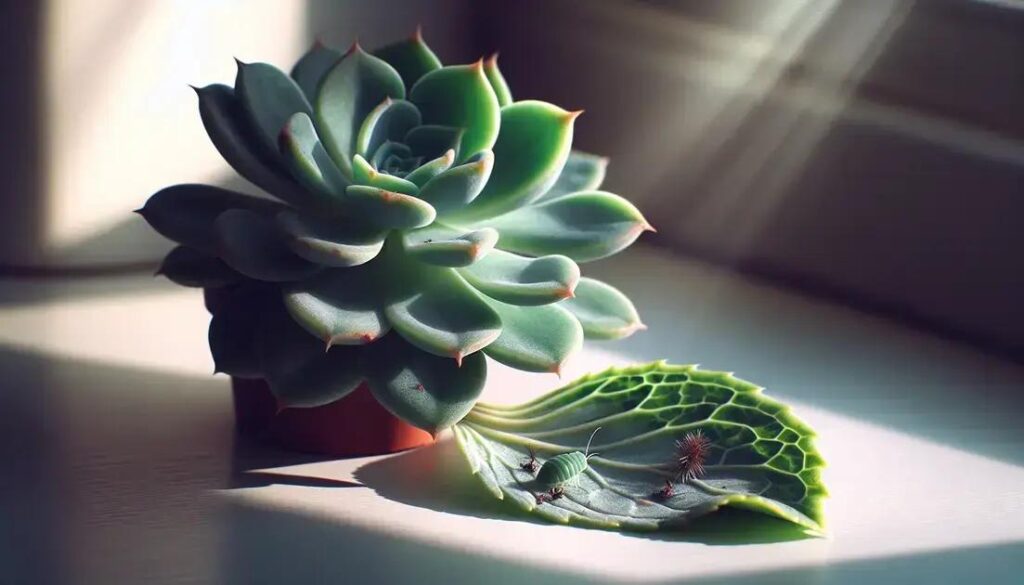If you’ve found yourself asking, “Why are my succulent leaves falling off?” you’re not alone. Succulents are popular for their low-maintenance appeal, but they can still encounter problems. Understanding the causes behind falling leaves can help you nurture a thriving plant. From watering techniques to light conditions, let’s explore the factors that might lead to succulent leaf drop.
Common Causes of Succulent Leaf Loss
Succulents are known for their resilience, but even they can sometimes lose leaves. A common culprit in succulent leaf loss is overwatering. Succulents store water in their leaves; when there’s too much water, they become bloated and fall off. Ensure your soil is well-draining and that the plant pot has proper drainage.
Another frequent issue is underwatering. When succulents don’t get enough water, their leaves shrivel and fall as the plant conserves resources. To avoid this, allow the soil to dry completely between waterings, then water thoroughly.
Sudden temperature changes can shock succulents, causing them to drop leaves. Keep your plants away from cold drafts or hot air. They thrive best in stable environments.
Too much sunlight can also scorch the leaves. If they appear red or brown and crispy, consider moving your succulent to a spot with filtered light.
Pests like mealybugs can sap the life out of your succulent, leading to leaf loss. Inspect your plants regularly and remove pests with a damp cloth or suitable insecticide.
Root rot from poor soil drainage is another critical factor. Ensure your soil mix is appropriate for succulents and consider repotting if roots appear black or mushy.
Finally, stress factors such as sudden location changes or transplant shock can also cause leaf shedding. Be gentle when moving and handling plants, and give them time to adjust after a move.
Is Overwatering the Reason Your Succulent Leaves Are Falling Off?
One of the common reasons succulent leaves fall off is overwatering. Succulents, being drought-tolerant plants, thrive in dry conditions with minimal water. Overwatering leads to root rot, as the soil retains too much moisture, causing the roots to suffocate.
As a result, the leaves turn mushy, yellow, and eventually detach from the plant. It’s vital to check the soil’s moisture level before watering. Ensure you have a well-draining potting mix to avoid water retention.
A simple way to determine if overwatering is the culprit is to observe the base of the fallen leaves. If they’re soft and translucent, overwatering is likely the cause. It’s crucial to adjust your watering schedule, allowing the soil to dry out between watering sessions. Monitor your succulents regularly to maintain their health and prevent further leaf loss.
How Underwatering Can Lead to Leaf Drop in Succulents
Underwatering is a frequent yet often overlooked cause of leaf drop in succulents. When succulents are deprived of adequate moisture, they respond by shedding leaves as part of their survival strategy. Without enough water, their cells shrink, leading to wrinkling and eventual leaf detachment.
To assess if underwatering is the issue, check the leaves’ texture and appearance. Dry, crispy, or shriveled leaves are indicators of insufficient watering. The plant’s overall appearance might be dull and lifeless, reflecting its struggle to conserve water.
A succulent’s soil can also offer clues. Dry, crumbly soil persisting even after supposed regular watering is a red flag. Inadequate watering frequency or too small quantities can lead to these conditions. Be sure to water thoroughly and allow excess water to drain completely.
Keep in mind that
proper watering
is seasonal. More frequent watering is needed during growth periods, while dormancy requires less. Adjust your watering schedule to match these needs, ensuring a balance that supports your succulent’s health and prevents leaf drop.
Addressing underwatering promptly can halt leaf drop and facilitate recovery. By understanding and monitoring your succulent’s hydration requirements, you can maintain its resilience and vibrancy.
The Impact of Sudden Temperature Changes on Succulent Leaves
Sudden temperature changes can significantly affect succulent leaves, causing them to drop unexpectedly. Succulents are adapted to specific climatic conditions, especially those with stable temperatures. When exposed to abrupt fluctuations, such as moving from indoor warmth to chilly outdoor air, their leaves may fall off as a stress response.
These temperature shifts can disrupt the plant’s internal balance, making it hard for succulents to maintain their hydration levels. Cold air can cause cell damage, leading to leaf drop. Similarly, unexpected heat surges might accelerate water loss through transpiration, leaving the succulent dehydrated. To prevent these issues, gradually acclimate your succulents to different environments, or use protective coverings to shield them from extreme temperature swings.
Avoid placing succulents near air conditioning vents or drafts, as these areas tend to have frequent temperature variations that can shock the plants. Creating a stable and suitable climate is crucial for the health of your succulent leaves, ensuring they remain intact and vibrant.
How to Tell If Your Succulent Is Getting Too Much Sunlight
Understanding the impact of sunlight on succulents is crucial for their health. Signs of excessive sun exposure include leaves that are turning brown or dry. If your succulent’s normally plump leaves start to look scorched or bleached, it may be getting too much sunlight.
Identifying Sunburn in Succulents
Just like people, succulents can get sunburned, and it’s often the tip or center of the plant that shows damage first. You’ll notice paling colors, with the vibrant greens or other hues fading under intense light. If you see crispy edges forming, it’s time to move your plant to a more shaded location.
Adjusting Exposure
Succulents thrive in bright but indirect sunlight. If they receive harsh, direct sun rays for more than a few hours, they’ll start to suffer. It’s essential to find a balance between light and shadow. Consider introducing a sheer curtain if your succulents are indoors or reposition them if they’re outside to ensure they get optimal light without risking sun damage.
The Role of Observation
Regularly check the color and firmness of your succulent’s leaves. Healthy leaves should be vibrant and firm to the touch. If they start looking washed out, it might indicate too much sunlight. Making slight adjustments to their placement based on these observations can prevent long-term damage and leaf loss.
Protecting Your Succulent
In particularly hot climates, consider using a shade cloth to protect your plants during peak afternoon sun. This could help prevent leaf damage and ensure your succulent continues to thrive. Gradual acclimatization to higher light levels can also be beneficial.
Being vigilant and responsive to changes will help keep your succulents healthy and happy, avoiding any surprise leaf loss caused by too much sunlight.
Are Pests Causing Your Succulent Leaves to Fall Off?
If you notice your succulent leaves falling off, it’s crucial to consider if pests could be the underlying issue. Certain pests are known to cause significant damage to succulents, resulting in leaves dropping unexpectedly.
Aphids are tiny insects that love to feast on the leaves and stems of succulents. They can cause leaf drop by weakening the plant’s structure, making it difficult for leaves to stay attached.
Another notorious pest is the mealybug. These pests extract nutrients from the succulent, leading to weaker leaves that are more prone to falling off. Mealybugs often appear as white, cotton-like masses on the plant.
Spider mites are microscopic arachnids that can infest succulents, causing leaves to turn yellow and drop. You might notice tiny webs on the leaves, which is a telltale sign of their presence.
Lastly, investigate for the presence of fungus gnats, which may not directly harm the leaves but can indicate root issues caused by larvae in the soil. Healthy roots are vital for securing leaf integrity on succulents.
Regularly inspect your succulents for these unwanted guests. Identifying the pest early can help in taking proactive measures to protect your plants. Implementing natural or chemical treatments can mitigate the damage and prevent further leaf drop.
How Root Rot Affects Succulent Leaves

Root rot is a common issue for succulents and can have a dramatic effect on their leaves. When roots are affected by rot, they cannot absorb vital nutrients and water effectively, leading to visible symptoms in the leaves.
Signs of Root Rot
One of the first signs of root rot is the appearance of black or mushy roots. If you notice succulent leaves turning yellow, soft, or mushy, it might indicate root rot. Another indicator is leaf drop. When roots fail, the leaves cannot receive the essential nutrients, resulting in wilting and eventual falling off.
Causes of Root Rot
Root rot is primarily caused by overwatering. Succulents need well-draining soil to prevent water from pooling at the roots. When plants sit in waterlogged soil, the roots become susceptible to mold and rot. Poor drainage and excessive humidity can also worsen the situation.
Preventing Root Rot
The key to preventing root rot is to ensure your succulents are planted in an appropriate soil mix that drains well. Watering frequency should be adjusted according to the season and climatic conditions. Ensure pots have drainage holes and avoid letting your succulents sit in stagnant water.
Remedying Root Rot
If you suspect root rot, gently remove the succulent from its pot and examine the roots. Trim any black or mushy roots, and let the plant dry out before repotting in fresh, well-draining soil. By addressing root rot promptly, you can help your succulents recover and thrive once more.
Stress Factors That Cause Succulents to Shed Leaves
Succulents are hardy plants known for their resilience, but several stress factors can lead to leaf loss. It’s essential to identify these stressors to keep your succulent healthy.
Environmental Stress
Succulents require specific environmental conditions. Temperature extremes, whether too hot or too cold, can cause stress. Sudden changes in temperature can lead to leaves dropping off. Maintaining a consistent environment is key for preventing this stress.
Lack of Adequate Nutrients
Succulents can suffer if they do not receive adequate nutrients. While they do not require frequent feeding, a lack of nutrients can stress them, leading to leaf loss. Use a balanced, low-nitrogen fertilizer to provide necessary nutrients.
Improper Watering
Succulents are sensitive to their watering schedule. Underwatering can cause leaves to dry and drop, while overwatering can lead to root rot, another form of stress that causes leaves to fall off. Ensure proper watering techniques to avoid stress from improper water levels. Always allow the soil to dry out between waterings.
Physical Damage
Physical damage to succulents, such as bruising or cuts, can lead to stress-related leaf shedding. Be careful when handling these plants to prevent unnecessary stress.
By understanding and minimizing these stress factors, you can help prevent your succulent from shedding leaves, ensuring a thriving plant.
Seasonal Leaf Drop in Succulents: What to Know
Understanding seasonal leaf drop in succulents is crucial for maintaining their health and beauty. As seasons change, succulents can naturally shed leaves, which is a normal part of their growth cycle. During autumn and winter, many succulents enter a dormancy period. In this phase, it’s common for older leaves to fall off as the plant conserves energy.
Temperature fluctuations play a significant role in seasonal leaf drop. As outdoor temperatures drop, indoor succulents may experience shock if they’re too close to cold window panes or exposed to drafts. Ensure your succulents are kept in a stable environment with temperatures that mimic their native habitats.
Light levels also change with the seasons, affecting leaf retention. During shorter days, succulents might receive less sunlight, leading to additional leaf drop. Ensure your plants are positioned in bright, indirect sunlight throughout the day to minimize seasonal shedding.
Finally, adjust your watering routine to suit the season. Overwatering succulents during their dormant period can lead to root rot and leaf loss. Instead, water sparingly, allowing the soil to dry out completely between watering sessions.
With these tips in mind, you can manage seasonal leaf drop in succulents and keep them healthy all year round.
How Transplant Shock Can Cause Leaf Loss in Succulents
When a succulent is moved from one environment to another, it can experience a condition known as transplant shock. This phenomenon is particularly common when the growing conditions are drastically different. Transplant shock can cause stress that results in leaves falling off.
Succulents are known for their ability to adapt to arid conditions, but even they need time to adjust. When you transplant a succulent, its roots might struggle to absorb nutrients effectively in the new soil, especially if it’s not well-draining. This can lead to nutrient deficiencies, causing the succulent to shed leaves as a survival mechanism.
Moreover, the physical act of transplanting can damage the delicate roots. Root disturbance often leads to a condition called root damage, which hampers the plant’s ability to take up water, leading to dehydration and subsequent leaf loss.
Environmental factors play a significant role too. If the light, temperature, and humidity levels at the new site differ from what the succulent was accustomed to, it may respond by dropping leaves to conserve energy.
To mitigate transplant shock, ensure that you use suitable soil that allows for proper drainage, and place the succulent in conditions similar to its previous environment. Gradual acclimatization is key to preventing excessive leaf loss. Water sparingly but consistently and avoid adding fertilizer immediately after transplanting, as this can stress the plant further.
Improper Soil Drainage and Its Effect on Succulent Health
Succulents thrive in well-draining soil, as their roots require adequate aeration to prevent rot. When soil does not drain properly, it retains too much moisture, creating an environment conducive to root decay. This can significantly affect a succulent’s health, causing leaves to become soft, discolored, and prone to falling off. It’s crucial to use soil mixtures designed specifically for succulents, typically composed of sand, perlite, and gravel. Improving drainage by adding these components can greatly enhance root health and
prevent leaf loss
in succulents. Consider using pots with drainage holes to help excess water escape, thus reducing the risk of waterlogged roots.
How to Revive a Succulent with Dropping Leaves
Assess the Situation: Start by inspecting your succulent thoroughly. Look for any signs of overwatering, underwatering, pests, or sudden changes in environment. Each of these factors could lead to leaf dropping, so identifying the most likely cause is crucial.
Correct Watering Practices: Adjust your watering schedule based on the diagnosis. If the roots are too dry, gradually increase hydration, ensuring excess water can drain away. For overwatered plants, reduce watering frequency and allow the soil to dry out completely before their next drink.
Optimize Lighting Conditions: Position your succulent in an area with adequate indirect sunlight. Direct exposure in hot climates or prolonged darkness can stress the plant. Always aim for a balance to suit the succulent’s needs.
Examine Soil and Root Health: Carefully remove the succulent from its pot to check the roots. Healthy roots appear firm and white, while rotting roots will look brown and mushy. If root rot is detected, trim affected areas and replant in fresh, well-draining soil.
Consider a Stress-Free Environment: Maintain a steady environment without rapid temperature changes. Avoid relocating the plant frequently and ensure adequate airflow, which can help stabilize its conditions.
Approach Transplant with Care: When repotting succulents to revive them, use a cactus mix or one part potting soil, one part perlite, and one part sand to help with drainage. Gently handle roots to minimize shock.
By carefully adjusting the care routine to meet your succulent’s specific needs, you increase the chances of it thriving once more. Patience is key as changes in its environment or routine can take time to manifest in its health. Regular monitoring will aid in ensuring a healthy revival.
How to Revive a Succulent with Dropping Leaves
Caring for succulents can be simple, but when their leaves start to drop, it’s a sign they need some extra attention. Identifying the cause of leaf drop is crucial to reviving your plant. Begin by inspecting the leaves for signs of overwatering, such as softness and mushiness. If the soil is dense and wet, consider repotting the plant in a well-draining succulent soil mix with a drainage hole.
On the other hand, if the leaves appear wrinkled and dry, gently water the plant until the soil is moist, not soaked. Remember to water the plant once the soil completely dries out. Avoid direct sunlight exposure if the leaves are scorched, and gradually acclimate the plant to indirect sunlight to help it recover.
Additionally, check for pests such as aphids or mealybugs beneath the leaves and on the stem. If found, gently remove them with a damp cloth or cotton swab dipped in alcohol. Consistent care and attention to environmental factors will encourage your succulent to thrive once more.






